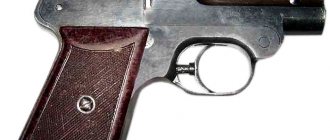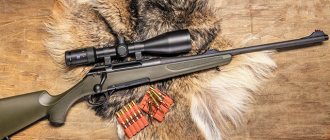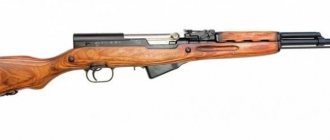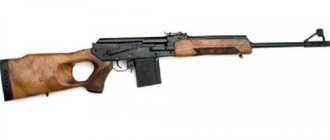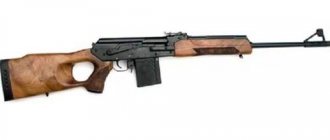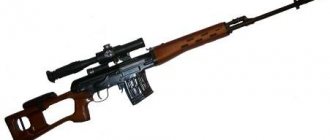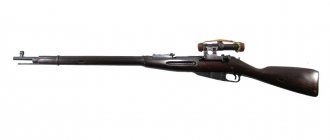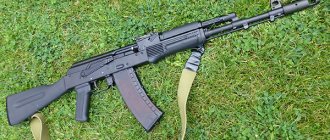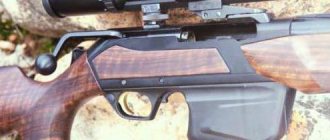World weapon legends. Roth-Haenel carbine
The history of the first self-loading hunting weapon
The Roth-Haenel self-loading carbine is one of the first self-loading rifle systems put into mass production, and, presumably, the first purely hunting self-loading carbine. The authorship of this design belongs to Karel Krnka, an Austro-Hungarian designer of Czech origin, who worked at the Austrian factory of Georg Roth (G.Roth Metallwaren und Munitionfabriken) in the city of Vienna at the end of the 19th century. Since Roth himself did not have sufficient production capacity to produce weapons, he licensed the production of weapons at other factories - OEWG Steyr in Austria or CGHaenel in Germany.
In 1899, Georg Roth, as the owner of the company, registered in his name and the name of the real inventor a patent for the design of a self-loading weapon that uses recoil energy for reloading. This system used a long barrel stroke, that is, the recoil length of the barrel with the bolt in the locked state after firing exceeded the length of the cartridge used. In the rearmost position, the bolt frame was stopped by a special latch, and the barrel, under the influence of a return spring placed on it, began to move forward, dragging the bolt along with it. The movement of the bolt relative to the bolt frame caused the bolt to rotate due to the interaction of shaped bevels and protrusions, and as a result of the rotation, the bolt disengaged from the barrel and stopped, holding the cartridge case with the ejector hook, and the barrel continued to move forward. After the barrel had moved forward a sufficient distance, the cartridge case released from the chamber was thrown out, and in the extreme forward position the barrel disengaged the bolt frame latch, so that, under the influence of its own spring in the rear part of the receiver, it moved forward together with the bolt, loading the barrel with a new cartridge from the magazine and at the end locking the barrel bore with the bolt port, which had two lugs in the front part.
The trigger mechanism had a fairly simple striker design, using the return spring of the bolt group as a mainspring, and eliminated firing when the barrel was unlocked.
According to the patent, this system could be used in both pistols and rifles, and it became most famous in pistols - the Austrian Roth-Steyr M1907 and then (in a modified form) the Steyr-Hahn M1911. The rifle, due to its low prevalence, is much less known, mainly due to the fact that for its time it was extremely expensive.
For comparison, in 1903 in the United States, a Roth-Haenel rifle was sold for $150, which in modern money is more than 4 thousand dollars. At the same time, repeating rifles made by Haenel with manual reloading from the same dealer cost on average three times less, and a regular “Winchester” with lever reloading chambered for a cartridge of similar power could be bought even cheaper, for 30-40 dollars.
Roth-Haenel rifles had a wooden stock in which a fixed 5-round magazine was hidden. The magazine could only be loaded from below, after having folded down its cover with the feeder installed on it. The barrel with a return spring attached to it was, of necessity, hidden in a tubular metal casing. The rifle was equipped with both a conventional trigger mechanism and a “schnell” trigger with two triggers, popular in Europe.
It is interesting that in terms of the main design solutions (long barrel stroke, locking the bolt with two lugs, placing a return spring around the barrel in a tubular casing), the Krnka rifle design had significant similarities with the rifle patented a year later (in 1900) but much more famous and commercially successful Browning, produced in Belgium at the FN plant and in the USA at the Remington plant. The Browning system had a different design of the magazine and trigger mechanism, and the layout of the bolt group and the bolt return spring was noticeably different from the Austrian system, but there were more than enough similarities between the designs.
Another interesting fact about the Roth-Haenel rifle is that it was produced only for one cartridge developed by G. Roth, which had the metric designation 8.2x45mm. It was a purely hunting cartridge, equipped with shell or semi-jacket expansion bullets and intended for shooting at relatively short ranges. In this aspect, the Austro-German rifle also echoes the system of the legendary American, for which the Remington company created several special hunting cartridges of “intermediate” ballistics, from .25 Rem (6.35x52mm) to .35 Rem (9x49mm). If we talk about the Austrian 8.2x45mm cartridge itself, then it was equipped with bullets weighing 9.5 grams with an initial speed of about 550 m/s, which gives a muzzle energy of about 1350 Joules.
Haenel Jaeger 10 Mountain .308 Win
The Haenel Jaeger 10 carbine is a weapon of German quality, suitable for both driven hunting and targeted shooting. Haenel Jaeger 10 has manual reloading. The barrel is locked using a longitudinally sliding bolt with 6 lugs located in two rows on the bolt face. An extractor of spent cartridges is located on the shutter mirror. The carbine barrel is made by cold forging with very high internal processing. The barrel diameter at the muzzle is 16 mm. The shutter handle has a very openwork appearance, its diameter is 7.5 mm, but this does not reduce its strength. The shutter handle is moved back slightly and is at the level of the trigger. It is very convenient to use. The handle ends in a drop-shaped head with a diameter of 18 mm. The shutter rotation angle is 60°. The trigger mechanism (trigger mechanism) of the Henel Jaeger 10 carbine is striker-type and provides firing only with single shots. The trigger is a single direct action with a pusher, slightly shifted towards the rear wall of the trigger guard. The sneller is automatically switched off when the shutter is opened. The trigger pull force is 1.6 kg, but you can adjust it yourself to a different value. The trigger guard is made of impact-resistant synthetic material. A magazine release is integrated in the front of the trigger guard. The Haenel Jaeger 10 carbine is equipped with a safety catch, the flag of which is located on the right side of the weapon above the trigger. The fuse acts on the sear; when the flag is pulled back, the shutter is locked, but under the main fuse flag there is a button that is shown only when the flag is pulled back. The button is needed to allow the bolt to be pulled back when the safety is on. The receiver of the Henel Jaeger 10 carbine is made of two parts. The upper part of the receiver is a separate part, attached to the main part with screws. The stock of the Haenel Jaeger 10 carbine is a butt with a straight comb, smoothly turning into a Bavarian cheek. The butt plate has a soft-touch pad with a thickness of 13 mm. The forend of the carbine and the pistol grip are checkered. The stock has two transverse screw fastenings, which gives it a very recognizable appearance. The Henel Jaeger 10 carbine is equipped with mechanical sighting devices in the form of a rear sight and an adjustable front sight. The rear sight is made of synthetic material with a V-shaped slot with white edging. The front sight has a trapezoidal base with an adjustment unit and is made of synthetic materials. The front sight is equipped with a red fiber optic insert to improve aiming in low visibility conditions. You can also install an optical sight mounting bracket on the carbine. The Henel Jaeger 10 carbine is fed with cartridges using a removable box-type magazine with a capacity of 3 standard cartridges or 2 Magnum caliber cartridges. The magazine body is made of steel and inserted into a synthetic base. The magazine feeder is made of polymer material. Manufacturer: Haenel, Germany. The product description is for informational purposes only and may differ from the manufacturer’s description provided in the technical documentation.
Haenel Jaeger 10 plastic .308 Win
The Haenel Jaeger 10 carbine is a German quality weapon, suitable for both driven hunting and targeted shooting. Haenel Jaeger 10 has manual reloading. The barrel is locked using a longitudinally sliding bolt with 6 lugs located in two rows on the bolt face. An extractor of spent cartridges is located on the shutter mirror. The carbine barrel is made by cold forging with very high internal processing. The barrel diameter at the muzzle is 16 mm. The shutter handle has a very openwork appearance, its diameter is 7.5 mm, but this does not reduce its strength. The shutter handle is moved back slightly and is at the level of the trigger. It is very convenient to use. The handle ends in a drop-shaped head with a diameter of 18 mm. The shutter rotation angle is 60°. The trigger mechanism (trigger mechanism) of the Henel Jaeger 10 carbine is striker-type and provides firing only with single shots. The trigger is a single direct action with a pusher, slightly shifted towards the rear wall of the trigger guard. The sneller is automatically switched off when the shutter is opened. The trigger pull force is 1.6 kg, but you can adjust it yourself to a different value. The trigger guard is made of impact-resistant synthetic material. A magazine release is integrated in the front of the trigger guard. The Haenel Jaeger 10 carbine is equipped with a safety catch, the flag of which is located on the right side of the weapon above the trigger. The fuse acts on the sear; when the flag is pulled back, the shutter is locked, but under the main fuse flag there is a button that is shown only when the flag is pulled back. The button is needed to allow the bolt to be pulled back when the safety is on. The receiver of the Henel Jaeger 10 carbine is made of two parts. The upper part of the receiver is a separate part, attached to the main part with screws. The stock of the Haenel Jaeger 10 carbine is a butt with a straight comb, smoothly turning into a Bavarian cheek. The butt plate has a soft-touch pad with a thickness of 13 mm. The forend of the carbine and the pistol grip are checkered. The stock has two transverse screw fastenings, which gives it a very recognizable appearance. The Henel Jaeger 10 carbine is equipped with mechanical sighting devices in the form of a rear sight and an adjustable front sight. The rear sight is made of synthetic material with a V-shaped slot with white edging. The front sight has a trapezoidal base with an adjustment unit and is made of synthetic materials. The front sight is equipped with a red fiber optic insert to improve aiming in low visibility conditions. You can also install an optical sight mounting bracket on the carbine. The Henel Jaeger 10 carbine is fed with cartridges using a removable box-type magazine with a capacity of 3 standard cartridges or 2 Magnum caliber cartridges. The magazine body is made of steel and inserted into a synthetic base. The magazine feeder is made of polymer material. Manufacturer: Haenel, Germany. The product description is for informational purposes only and may differ from the manufacturer’s description provided in the technical documentation.
